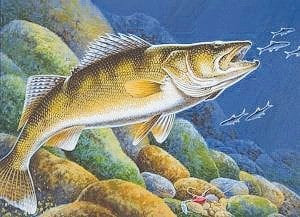Cook County fishermen will join with 500,000 Minnesotans who will ply the waters for (predominantly) walleyes on Saturday, May 13.
With the lakes free of ice, walleye should be done spawning by the opener, which means fish may be harder to find because they disperse after leaving the spawning grounds. But if fish are harder to find, they may be hungry and ready to bite by the opener.
Weather will be the key to the catch. Snow and cold tend to shut the bite down. Warm, sunny temps could result in nice catches for area anglers.
Fishing regulations and fishing licensees can now be obtained by going online www.dnr.state.mn.us as well as at local gas stations and tackle shops.
Once again anglers have the option of purchasing a walleye stamp to put on their licenses. Money earned from this purchase will be used to monitor and restock walleye lakes. It isn’t a mandatory purchase, like a trout stamp is, which allows fishermen to catch and keep their limit of trout.
“You can buy a walleye stamp any time of the year, even if you already have a fishing license,” said Neil Vanderbosch, DNR fisheries program consultant. “All the funds from walleye stamps go toward the cost of purchasing walleye from private fish farms for stocking into lakes.”
The overall walleye stocking effort ramps up each year in April when fisheries staff collect walleye eggs, fertilize them and transport the eggs to fish hatcheries around Minnesota. The eggs spend two to three weeks incubating before hatching into fry that are soon released – two-thirds into lakes and one-third into rearing ponds. The fish in rearing ponds grow into 4- to 6-inch fingerlings that are stocked into lakes in the fall.
In addition to raising and stocking walleye, the DNR also buys walleye fingerlings from private producers to be stocked into lakes, and walleye stamp sales help pay for these fish. Since 2009, funds from the walleye stamp have purchased over 40,000 pounds of walleye fingerlings that have been stocked in the fall, all over the state. Walleye are stocked in lakes that don’t have naturally reproducing walleye populations.
“Just about anywhere you go in Minnesota, there’s a lake fairly close by where you can fish for walleye,” Vanderbosch said. “To decide what lakes and how many fish to stock, we look at available habitat, prey and past stocking success, and make individual lake management plans that guide stocking decisions.”
Anglers catch the lion’s share of walleye from waters where the fish reproduce naturally – about 260 larger walleye lakes and in large rivers. Because of stocking, walleye can be found in an additional 1,300 Minnesota lakes spread throughout the state.
More information about habitat stamps can be found on the stamp program page.
Fishermen can obtain stocking reports from the local DNR office or by going online to www.DNR. state.mn.us lake finder.



Loading Comments